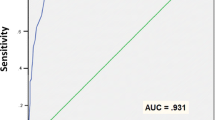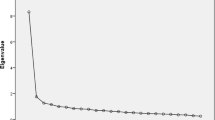Abstract
The heterosocial skills of 79 sex offenders were assessed using two self-report inventories, the Social Anxiety and Distress Scale (SAD) and the S-R Inventory of Anxiousness (SRI). In addition, staff members rated the offenders on modified versions of the SAD and the Heterosocial Skills Behavior Checklist for Males (HSB). Twenty-one offenders were also videotaped during a brief interaction with a female confederate. The tapes were rated using the HSB. All ratings and videotapings were conducted twice within a two-week period. The two self-report scales showed good test-retest reliability (r=.88) and correlatedr=.63 with each other. However, the SAD correlated significantly with the Crowne-Marlowe Social Desirability Scale and showed significant change from first to second administrations. The SRI showed less reactivity to social desirability and changed less over time. The staff ratings showed higher test-retest (r=.72–.76) than interrater (r=.36–.43) reliability. They correlatedr=−.56 with each other and did not show a significant relationship to the Crowne-Marlowe. However, both staff-ratings changed significantly from test to retest. Inspection of correlations between staff and self-report measures indicated that these instruments may be strongly affected by rater variance. Different measures completed by the same person correlated higher than the same measure completed by different persons. The HSB showed high levels of interrater agreement (90–100%) and split-half reliability (r=.95–.97). However, test-retest reliability was poor for the overall score and for the category measuring form of conversation. Categories measuring voice and affect were moderately reliable over time (r=.53–.74). However, the voice category scores changed substantially from first to second videotaping. On almost all measures used in this study, the sex offenders' scores were similar to those derived from normal populations. Only the category measuring affect on the HSB seemed to differentiate this group from normals.
Similar content being viewed by others
References
Abel, G. G., Blanchard, E. B., & Becker, J. V. Psychological treatment of rapists. In M. J. Walker & S. L. Brodsky (Eds.),Sexual assault. Lexington: Lexington Books, 1976.
Arkowitz, H., Lichtenstein, B., McGovern, K., & Hines, P. The behavioral assessment of social competence in males.Behavior Therapy, 1975,6, 3–13.
Barlow, D. H., Abel, G. G., Blanchard, E. B., Bristow, A. R., & Young, L. D. Heterosocial skills behavior checklist for males.Behavior Therapy, 1977,8, 299.
Borkoveck, T. D., Stone, N. M., O'Brien, G. T., & Kaloupek, D. G. Evaluation of a clinically relevant target behavior for analogue outcome research.Behavior Therapy, 1974,5, 503–513.
Burkhardt, P. L.Orientation booklet for sexual reorientation. Atascadero State Hospital, program IX, Dept. of Health, Atascadero, Calif., 1974.
Christensen, A., & Arkowitz, H. Preliminary report on practice dating and feedback as treatment for college dating problems.Journal of Counseling Psychology, 1974,21, 92–95.
Cohen, M., Seghorn, T., & Calmas, W. Sociometric study of the sex offender.Journal of Abnormal Psychology, 1969,74, 249–255.
Crowne, D. P., & Marlowe, D. A new scale of social desirability independent of psychopathology.Journal of Consulting Psychology, 1960,24, 349–354.
Curran, J. P., Gilbert, F. S., & Little, L. M. A comparison between behavioral replication training and sensitivity training approaches to heterosexual dating anxiety.Journal of Counseling Psychology, 1976,23, 190–196.
Eisler, R. M. Behavioral assessment of social skills. In M. Hersen & A. S. Bellack (Eds.),Behavioral assessment: A practical handbook, Oxford, U.K.: Pergamon, 1976.
Endler, N. S., Hunt, J. M., & Rosenstein, A. J. An S–R inventory of anxiousness.Psychological Monographs, 1962,76 (17 #536).
Futch, E. J., and Lisman, S. A. Behavioral validation of an assertiveness scale: the incongruence of self-report and behavior. Paper presented at AABT, Atlanta, December, 1977.
Gambrill, E. D., & Ritchey, C. A. An assertion inventory for use in assessment and research.Behavior Therapy, 1976,6, 550–561.
Gebhard, P. H., Gagnon, J. H., Pomeroy, W. P., & Christenson, C. V.Sex offenders. New York: Harper & Row, 1965.
Hersen, M., & Bellack, A. S. Assessment of social skills, In A. R. Ciminero, K. S. Calhoun, & H. E. Adams (Eds.),Behavioral Assessment. New York: Wiley, 1977.
Hersen, M., Eisler, R. M., & Miller, P. M. Development of assertive responses: clinical measurement and research considerations.Behaviour Research and Therapy, 1973,11, 505–521.
Laws, D. R., & Serber, M. Measurement and evaluation of assertive training with sexual offenders. In R. E. Hosford & C. S. Moss (Eds.),The crumbling walls: treatment and counseling of prisoners. Champaign, Ill.: University of Illinois Press, 1975.
MacDonald, M. L., Lindquist, C. U., Kramer, J. A., McGrath, R. A., & Rhyne, L. L. Social skills training: the effects of behavior rehearsal in groups of dating skills.Journal of Counseling Psychology, 1975,22, 224–230.
McGovern, K. B., Arkowitz, H., & Gilmore, S. K. Evaluations of social skills training programs for college dating inhibitions.Journal of Counseling Psychology, 1975,22, 505–512.
Mischel, W. Sex-typing and socialization. In P. Mussen (Ed.),Manual of child psychology (Vol. 2). New York: Wiley, 1970.
Rehm, L. P., & Marston, A. R. Reduction of social anxiety through modification of self-reinforcement: an instigation technique.Journal of Consulting and Clinical Psychology, 1968,32, 565–574.
Stockton, M. D., Legum, L., and McAnaney, M. A comprehensive treatment program for sex offenders. Unpublished manuscript, 1977 (available from the North Florida Evaluation and Treatment Center, Gainesville, Fla.).
Twentyman, C. T., & McFall, R. M. Behavioral training of social skills in shy males.Journal of Consulting and Clinical Psychology, 1975,43, 384–395.
Watson, D., & Friend, R. Measurement of social-evaluative anxiety.Journal of Consulting and Clinical Psychology, 1969,33, 448–457.
Author information
Authors and Affiliations
Rights and permissions
About this article
Cite this article
Alexander, B.B., Johnson, S.B. Reliability of heterosocial skills measurement with sex offenders. Journal of Behavioral Assessment 2, 225–237 (1980). https://doi.org/10.1007/BF01321440
Accepted:
Issue Date:
DOI: https://doi.org/10.1007/BF01321440




